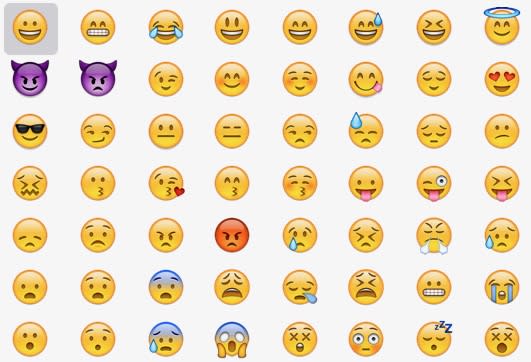Your silly emojis are going to court

Emojis represent a specialized dialect that many English speakers struggle with. The same can also be said of legalese. So when the two intersect, things can get complicated, and fast.
The array of symbols that we increasingly rely on for our messaging and social media are already starting to play a role in court cases. As I learned at a recent meetup of the DC Legal Hackers group (yes, such a thing exists), the odds are pretty good that this post-literate language won’t just be used to illustrate a court ruling but will show up in one soon.
As Susan Brenner, a law professor at the University of Dayton, observed in an (emoji-free!) email: “There are a lot of permutations that COULD come up in US court cases.”
I was only joking, your honor!
When you’re presenting an email or a text message to a jury, do you read aloud the colon-parenthesis representing a smiley face that ends a sentence, or do you skip over reading it as you would any other kind of punctuation? That came up during the 2015 trial of Ross Ulbricht, the creator of the Silk Road online drug marketplace.
The answer in that case: Yes, you note the presence of that emoticon and also show the text to the jury. Said judge Katherine B. Forrest at the time: “That is part of the evidence of the document.”
The guilty verdict for Ulbricht, first known only by his online pseudonym “Dread Pirate Roberts,” didn’t hinge on those emojis. But in other cases, these symbols have helped tilt a verdict one way or another.
Consider the smiley-face emoticon that began life as a colon and a parenthesis and its winky-face semicolon-parenthesis cousin. They can mean a lot of things: this is funny, I’m kidding, I like you, and so on. How should a judge or a jury read one at the end of a sentence that may or may not be incriminating?
In Lenz v. Universal Music Group—the 2010 “dancing baby case,” in which UMG claimed copyright infringement over Prince’s “Let’s Go Crazy” playing in the background of a 29-second YouTube clip of Stephanie Lenz’ kid dancing—a “;-)” in an email ended up helping out Lenz.
The judge said that the winking emoticon was Lenz being sarcastic about the “stilted language” of lawyers, not her admission that she wasn’t “injured substantially and irreparably” by UMG forcing YouTube to remove a video she’d uploaded to amuse friends and family.
But in cases like Elonis v. United States, appending cheerful emojis to threatening language —specifically, following up a remark about putting a friend’s spouse’s head on a stick with the playful sticking-your-tongue-out emoticon–didn’t fool anybody.
On the other hand, in February of 2015 a grand jury in Brooklyn declined to indict 17-year-old Osiris Aristy for posting an emoji of a police officer surrounded by handgun emojis — because the jurors didn’t consider that Facebook post a direct threat of violence.
You say squirt gun, I say handgun
Those last two cases didn’t require that much interpretation. But the increasing range of emojis — and their varying appearance in different operating systems — look sure to complicate life for judges and juries for some point.
Depending on what version of Windows or iOS you and your friend use, a handgun emoji can appear as a kid’s squirt gun or a toy ray gun–imagine how Aristy’s Facebook post could have looked with those substitutions. If you send a smiley-face emoticon in Microsoft Outlook, that image will show up as a “J” on devices not running Windows.
And even emojis that look the same everywhere can acquire other meanings. In practice, an eggplant has little to do with vegetables.
Benner sketched out one possible scenario: “Terrorists or other ‘bad actors’ are using emoji, probably a specifically created type of emoji, as a way to communicate.”
There’s already a market for software to pick out these inconsistencies — a Washington data-analytics firm called Boxer Analytics makes software to find and parse these symbols during the discovery phase of a case.
Gabriella E. Ziccarelli, an associate with Blank Rome LLP who gave a presentation on legal emojis at the Legal Hackers meetup, said that lawyers will want to test the emoji literacy of potential jurors. She suggested a possible screening technique: “Show a selection of emojis along with some questions to assess any biases.”
So far, it appears that only one court ruling has featured actual emojis — a British high-court ruling from February in which Justice Peter Jackson rejected a police contention that a smiley-face on a note was sarcastic.
But that’s bound to happen somewhere in the United States. Boxer Analytics CEO Joe Sremack, another presenter at the meetup, predicted in an email that “virtually every case involving digital communications will feature evidence that includes emojis within three years — including those at the Supreme Court level.”
So when will an emoji show up in a Supreme Court opinion? “Within 10 years, but likely less,” is Ziccarelli’s guess.
And what will that first SCOTUS-worthy emoji be? Sremack had his own predictions:
“It probably won’t be a happy emoji. The gun emoji is my guess, with the bomb and knife emojis following close behind.”
More from Rob:
The White House gathered tech leaders to tackle society’s biggest problems
Here’s the cybersecurity debate Clinton and Trump should have had
How HP’s decision to reject some ink cartridges reflects a much bigger problem
How the government plans to make your self-driving car safer
Email Rob at [email protected]; follow him on Twitter at @robpegoraro.
